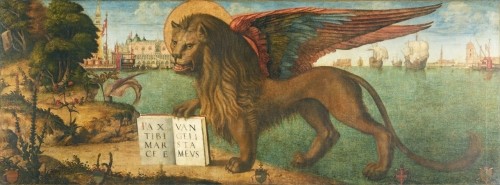
Written around the year 70, this earliest Gospel appears to have been composed in a church community that has recently experienced violence and persecution. Rome is a likely place of composition since the Roman church had been victimized by a campaign of torture under the Emperor Nero in the years 64-66, during which two great Christian leaders, Peter and Paul, probably died. Nero is reported to have crucified Christians in his private gardens, setting their crosses on fire to provide illumination after dark. Galilee/Syria is an alternative site because the churches there no doubt experienced pain and turmoil during the First Jewish-Roman War (66-70) and would have been grieved by the imminent destruction of the Temple and Jerusalem [see 13:7-8,14-16]. It is always possible that there was an original Galilean edition of the Gospel, followed rather quickly by a Roman revision, resulting in the form which we have today. Mark’s church seems to be mostly Gentile in composition; all foods, for instance, are considered clean [7:19].
The Evangelist wishes to: (1) spread the teachings of the waning apostolic generation; (2) foster fidelity to faith in Christ even in the face of torture; and (3) stress that Jesus’ divine Sonship is discernible only by experiencing Jesus’ Passion.
The Gospel is composed of two roughly equal sections. In the first half, Jesus is almost exclusively portrayed as a wonder- worker. The narrative proceeds at a frenzied pace, thanks to the repeated use of the word euthus, “immediately,” although this repetition is not always obvious in English translations. Crowds of people swarm to Jesus, removing the roof of a house, racing around the lake, preventing Jesus from eating, and hunting for him when he tries to find some solitude. At one point, two thousand possessed pigs commit mass suicide! [5:13]
But through all this, no human character in the narrative recognizes what Mark informs his readers about in various ways; namely, that Jesus is God’s Son. Pharisees, Herodians and scribes, the crowds, the disciples, and even his family (who come to take charge of Jesus because people think he's crazy [3:21]), are all shown to be confused and ignorant. The disciples are portrayed as especially imperceptive, never seeming able to grasp who Jesus is despite the frequent private tutoring they receive (see especially 8:13-21, which occurs after not one, but two, feedings of the multitude [6:30ff; 8:1ff]).
The Gospel's tone changes after the pivotal central scene in which Peter declares Jesus to be the Anointed One [8:27-31]. Jesus then begins a series of three instructions that the Son of Man will suffer and die. The disciples continually fail to grasp this, falling to rivalries among themselves and ploys to advance their own glory. In the end, Jesus is completely abandoned by everyone. Even clothing is left behind in the frantic haste to escape from the scene of Jesus’ arrest [14:51-52]. Peter curses Jesus while trying to disassociate himself from him [14:71]. Jesus dies utterly alone [15:34].
But immediately someone finally perceives Jesus' identity. The centurion, “seeing the manner of his death,” is the first human being in the Gospel to recognize, “truly this man was God’s Son” [15:39]. This climactic punch line of the Gospel even overshadows the events of Easter because Mark offers no resurrection appearances. Instead he concludes his Gospel with the women fleeing from the tomb, “saying nothing to anyone” [16:8].
This seems directly aimed at the distress of the Marcan Christians. They learn that they must take up their crosses and follow Jesus, and not lose their lives trying to save them [8:34-35], that it is better to lose hands, or feet, or eyes [to torture?] rather than stumble in their faith [9:43-48], and that to be great is to be the slave of all, just as Jesus gave his life as a ransom for many [10:44-45]. Mark’s church is admonished to endure their tribulation because “this generation will not pass away” before Jesus returns in triumph [13:30]. They are also instructed to avoid false messiahs who perform signs and wonders [13:22]. This is part of Mark’s insistence that authentic faith in Jesus cannot be generated by flashy marvels. Finally, the story of Peter shows that there is hope for the restoration of those Marcan Christians who, under threat of torture, curse the name of Jesus to save their own skins. (Requiring such cursing of Jesus is a known Roman strategy from a later persecution to determine if those who claimed not to be Christians were telling the truth.)
The main christological idea in Mark is that no one can really comprehend divinity of Jesus unless they perceive him as the one who was crucified, and are ready themselves to share in that suffering. Thus, authentic discipleship is defined not by glory or wonders, but by self-sacrificing service. The icon for this Gospel is thus a cross, the sign which makes Jesus’ divine Sonship perceptible.


